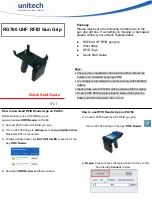
Transmission of Scanner Commands
10
MP150 Protocol
3.2
Answer
After transmission of the BCC, the scanner will reply with either ACK, NAK or ETB. These replies have
the following meanings:
ACK
- The command contains the proper syntax and is acknowledged by the scanner.
NAK
- There are syntax errors in the command, or the BCC is wrong
–
it will not be acknowledged. The
wrong command does not cause changes in the scanner. It has to be corrected and/or repeated.
ETB
- The internal diagnosis software in the scanner has spotted an error. This error must be corrected,
and thereafter, the command must be repeated as it could not be implemented due to the
scanner error.
3.3
Requesting Parameters from the Scanner
The retrieval of previously defined functions and parameters is possible using the following format:
SOH ”G” Operation Code [Sector] EOT BCC
The method of defining the operation code for retrieval of parameters is similar to the setting of the
parameters. The operation code is prefixed by a ”G” (for ‘Get’).
For sector parameter requests, the sector number must be present after the command code.
After transmitting the BCC, the scanner will reply with ACK, NAK or ETB in the same way it does when
issuing commands (see section
). These replies have the same meaning as during the transmission of
commands, and NAK / ETB have the same handling requirements.
After replying ACK, the scanner will transmit the parameter(s), using the same format as the PC does
when issuing a command. However, the scanner does not require an ACK or NAK signal from the PC.
For example, if transmission of the current line count is desired, the computer requests the parameter
by issuing:
SOH ”GLC” EOT BCC
If the transmission is correct the scanner will reply:
ACK SOH ”TR1” EOT BCC
Should any error occur in the checksum, the parameter request should be repeated.
Summary of Contents for LineScanner MP150
Page 1: ...MP150 Linescanner Protocol Manual Rev B4 Aug 2019 51101...
Page 2: ......











































